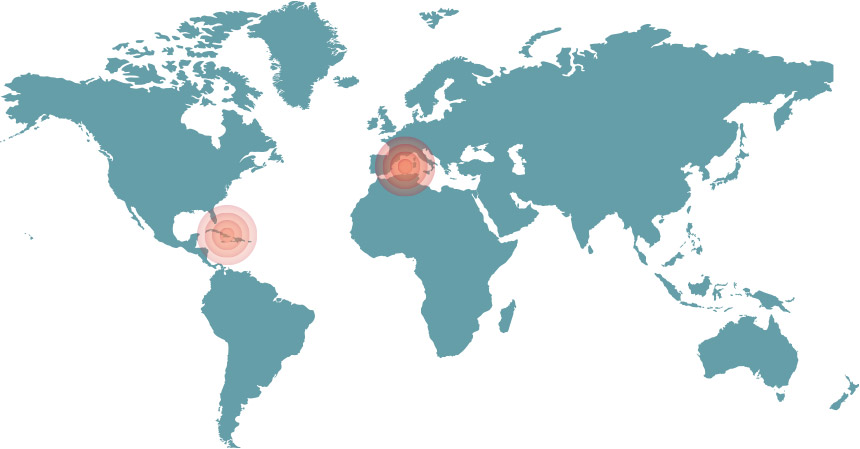Enhancing community benefits from biodiversity
Many farmers like me have begun to understand that the conservation of our soil and our forests is critical to our own well-being.
CEPF conservation strategies factor in the concerns of local communities and pursue opportunities to meet the immediate needs of the people while ensuring a healthy future for the ecosystems around them.
Caribbean Islands Biodiversity Hotspot
CEPF grantees have been working in La Humeadora Mountain National Park in the Dominican Republic on projects that provide economic and health benefits while improving environmental awareness and park management.
Although this protected area supplies about 70 percent of the city of Santo Domingo’s water supply, the park had very little staff or infrastructure prior to 2013. Park buffer zones were often cleared for cash crops using slash-and-burn techniques.
CEPF grantee Fondo Pro Naturaleza (PRONATURA) engaged local governments and communities in the development of a sustainable management plan for La Humeadora.
PRONATURA led more than 15 educational workshops for 450 people from the local municipalities—and, in the past three years, trained 14 park rangers and outfitted them with the tools needed for monitoring endangered species. Some who once caught birds to sell to the pet trade now work to protect them, with salaries paid by the national government.

A community nursery now produces native tree seedlings. PRONATURA provides technical advice to local farmers on topics such as soil conservation, and encourages the use of analog forestry on their plots, including the planting of native trees alongside fruit and cocoa trees, instead of slash-and-burn farming. This effort has increased wildlife corridors around the park, while proving exponentially more profitable. One farmer, for example, reported an income increase from US$78 to US$179 every two weeks. That economic boost has, in turn, reduced encroachment into the park.
Almost 18,200 hectares of parkland are now under better management, and more than 98.5 hectares of forest have been restored.
“The communities and the Ministry of Environment have a developed a strong bond that has greatly benefited the park,” said Park Manager Marcos Corporán. “Now we are doing clean-ups, reforestation and maintenance activities, and working on the agroforestry lots, always together. And the communities benefit as well. You can see an increased well-being.”
PRONATURA has also worked through the Pure Water Foundation to provide some local residents with filters to prevent intestinal ailments, particularly for children.
The Instituto Tecnológico de Santo Domingo (INTEC), another CEPF grantee, conducted several studies in the park to determine the economic value of water services provided by the watershed, including human consumption, irrigation and hydroelectric energy. Surveys showed that water consumers in the region are willing to pay an additional US$8.60 per year to support the park. If a proposed payment plan is accepted, the money earned could fund the park’s conservation efforts.
It is estimated that the combination of improved parkland and enhanced management has benefitted more than
2 million water users in Santo Domingo.
Mediterranean Basin Biodiversity Hotspot
In Morocco, the Bou Areg Laguna (also known as Mar Chica) is quickly becoming a priority for North African tourism and development interests. The area’s gorgeous beaches, flower-filled sand dunes, and clear blue waters make it a magnet for vacationers, and investors are interested in building large luxury hotels.
The unique lagoon—the largest on the southern shore of the Mediterranean—is also a draw for fishing boats and anglers. Bou Areg is home to 13 fish, nine mollusks, two cephalopods and two crustacean species. Those, in turn, attract numerous birds. Many migratory species winter over, while others find ample nesting space in the wide dunes that separate Bou Areg from the sea. Coastal wetlands here have been designated as being of international importance under the Ramsar Convention.
The Association de Gestion Intégrée des Ressources (AGIR) has used CEPF funding to ensure that future human use and development in the area will be balanced with wildlife needs.
One area of the lagoon is soon to be designated as a “no fishing zone,” allowing a fish nursery to develop. AGIR has formed a cooperative, enabling local fishermen to get better prices for their catch.
AGIR is also providing 150 local fishing boats with isothermic insulation compartments. These units help prevent spoilage in the hot sun, allowing storage of catch for two full days, as opposed to fish becoming unsellable in just an hour or two.
Both the better pricing and the coolers allow fishermen to make a living wage without sacrificing the fishery’s health, and workshops have helped members of the cooperative adopt sustainable fishing practices.
Photo Credits
Sunset, Bou Areg Laguna. © AGIR
La Humeadora Mountain National Park, Dominican Republic. © Conservation International/photo by Michele Zador




